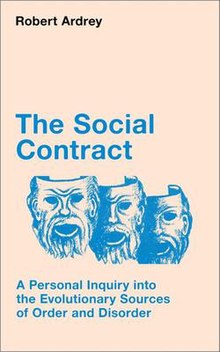The Social Contract (1970 book)
 |
|
| Author | Robert Ardrey |
|---|---|
| Illustrator | Berdine Ardrey (neé Grunewald) |
| Language | English |
| Series | Nature of Man Series |
| Subject | Paleoanthropology, Human evolution |
| Genre | Science |
| Published |
|
| Media type | |
| Pages | 404 |
| ISBN | |
| Preceded by | The Territorial Imperative |
| Followed by | The Hunting Hypothesis |
The Social Contract: A Personal Inquiry into the Evolutionary Sources of Order and Disorder is a 1970 Paleoanthropology book by Robert Ardrey. It is the third in his four-book Nature of Man Series.
The book extended Ardrey's refutation of the prevailing conviction within social sciences that all social behavior is purely learned and not governed by innate patterns. Through interwoven analyses of animals and human social structures Ardrey argued that inherited evolutionary traits are an important determining factor in social behavior.
Ardrey dedicated The Social Contract to Jean-Jacques Rousseau, after whose 1762 work the book was titled.
The Social Contract was published in 1970. It was the third book in Ardrey's Nature of Man series, following African Genesis and The Territorial Imperative and preceding The Hunting Hypothesis.
The Social Contract continues Ardrey's work on understanding how evolutionarily inherited traits are manifest by contemporary man. In particular The Social Contract examines society and hierarchy in terms of genetic diversity. The edition cites many of the scientists who were important influences on Ardrey, including Raymond Dart and Konrad Lorenz. It was illustrated, like the first two books, by Ardrey's wife, the South African actress and illustrator Berdine Ardrey (née Grunewald).
The Social Contract is a more ideologically motivated book than the other works in his Nature of Man series. It made assertions about how the social contract should be organized based on the evolutionary nature of man. In his last chapter, Ardrey writes:
The evolutionary nature of man represents, as I see it, a subject for the new philosophy, the new theologian. A set of common assumptions, common dedications, common assurances, of rules and regulations, even considering the limitations of homo sapiens, remains someday possible. As all of our parochial dedications have been eroded by the wash of the science, still a religion unassailable by the sciences exists as a goal worthy of contemporary ambition.
...
Wikipedia
